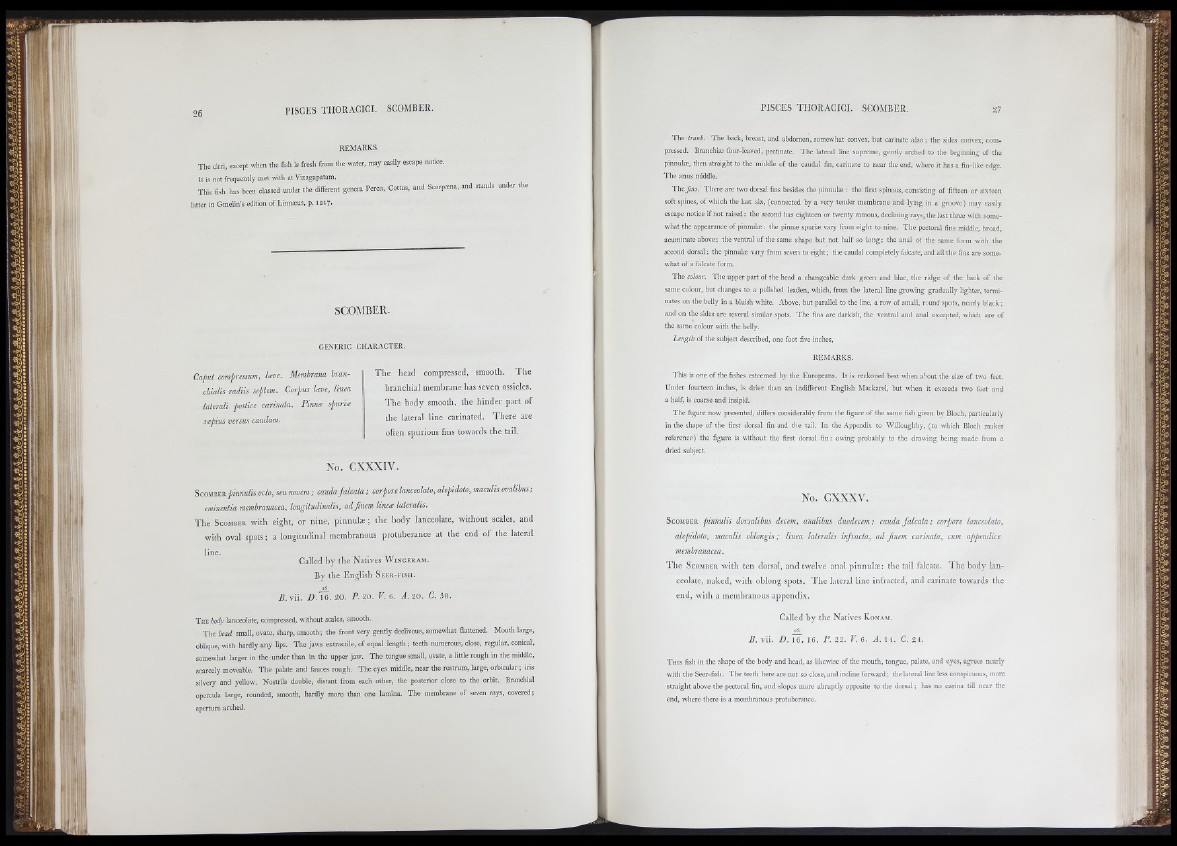
Il il I I I
I- li:
Tlie cirri, except wlien the fish is fresh from the water, may e isily escape notice.
It is not frequently met with at Vizagapatam.
This fish has been classed under the different genera Perca, Cottas, and ScorpEua, and stands under the
latter in Gmelin’s edition of Limisus, p. 1217.
S C O M B E R .
GENERIC CHARACTER.
Cajmt compressum, l<eve. Membrana branchialis
radiis septem. Corpus Uve, linea
laterali postice carinata. Pinne spurie
septus versus caudam.
T h e head compressed, smooth. T h e
b ranchia l membrane has seven ossicles.
T h e body smooth, the h in d er p a rt o f
the lateral line carinated. T h e re are
often spurious fins towards the tail.
N o . C X X X IV .
S c o n tiu pinnulis oclo, sen novem ; cauda falcata ; corpore lanceolato, alepidoto, macidis ovalibus:
eminentia membranacea, longiludinalis, adjinem lineee lateralis.
T h e S c om b e r with eight, or nine, pinnulæ ; the body lanceolate, without scales, and
with oval spots; a longitudinal membranous protuberance at the end o f the lateral
line.
Called b y the Natives W in g e r am .
By the English S e e r - f i s h .
16
Z . vii. D. 16. 20. P. 20. V. 6. A. 20. C. 30.
T h e body lanceolate, compressed, without scales, smooth.
The head small, ovate, sharp, smooth; the front very gently declivous, somewhat flattened. Mouth large,
oblique, with hardly any lips. The jaws extractile, of equal length ; teeth numerous, close, regular, conical,
somewhat larger in the-under than in the upper jaw. The tongue small, ovate, a little rough in the middle,
scarcely moveable. The palate and fauces rough. The eyes middle, near the rostrum, large, orbicular ; iris
silvery and yellow. Nostrils double, distant from each other, the posterior close to the orbit. Branchial
opercula large, rounded, smooth, hardly more than one lamina. The membrane of seven rays, covered ;
aperture arched.
The trunk. The back, brea.st, and abdomen, somewhat convex, but carinate also ; the sides convex, compressed.
Branchiæ four-leaved, pectinate. The lateral line supreme, gently arched to the beginning of the
pinnulæ, then straight to the middle of the caudal fin, carinate to near the end, where it has a fin-like edge.
The anus middle.
The jînj. There are two dorsal fins besides the pinnulæ : the first spinous, consisting of fifteen or sixteen
soft spines, of which the last six, (connected by a very tender membrane and lying in a groove) may easily
escape notice if not raised ; the second has eighteen or twenty ramous, declining rays, the last three with somewhat
the appearance of pinnulæ; the pimiæ spuriæ vary from eight to nine. The pectoral fins middle, broad,
acuminate above; the ventral of the same shape but not half so long; the anal of the same form with the
second dorsal ; the pinnulæ vary from seven to eight ; the caudal completely falcate, and all the fins are somewhat
of a falcate form.
The colour. The upper part of the head a changeable dark green and blue, the ridge of the back of the
same colour, but changes to a polished leaden, which, from the lateral line growing gradually lighter, terminates
on the belly in a bluish white. Above, but parallel to the line, a row of small, round spots, nearly black ;
and on the sides are .several similar spots. The fins are darkish, the ventral and anal excepted, which are of
the same colour with the belly.
Length of the subject described, one foot five inches,
REMARKS.
This is one of the fishes esteemed by the Europeans. It is reckoned best when about the size of two feet,
Under fourteen inche.s, is drier than an indifferent English Mackarel, but when it exceeds two feet and
a half, is coarse and insipid.
The figure now presented, differs considerably from the figure of the same fish given by Blocli, particularly
in the shape of the first dorsal fin and the tail. In the Appendix to Willoughby, (to which Bloch makes
reference) the figure is without the first dorsal fin: owing probably to tiie drawing being made from a
dried subject.
N o . C X X X V .
S c om b e r pinnulis dorsalibus decem, analibus duodecem; cauda falcata ; corpore lanceolato,
alepidoto, maculis ohlongis ; linea lateralis injracta, ad Jinem carinata, cum appendice
membranácea.
T h e S c om b e r witii ten dorsal, and tvvelve anal p in n u læ : the tail falcate. T h e body lan ceolate,
naked, with oblong spots. T h e lateral line infracted, and carinate towards the
end, with a membranous appendix.
Called b y the Natives Ko n am.
16
B . vii. -D. 16. 16. Z. 22. V. 6. A. 14. C. 24.
T his fish in the shape of the body and head, as likewise of the mouth, tongue, palate, and eyes, agrees nearly
with the Seer-fish. The teeth here are not so close, and incline forward ; the lateral line less conspicuous, more
straight above the pectoral fin, and slopes more abruptly opposite to the dorsal; has no carina till ncai- the
end, where there is a membranous protuberance.